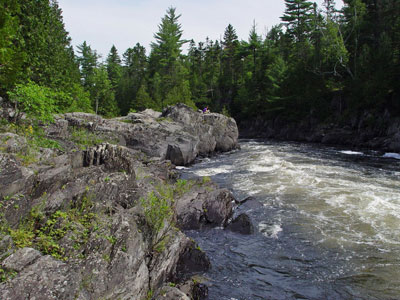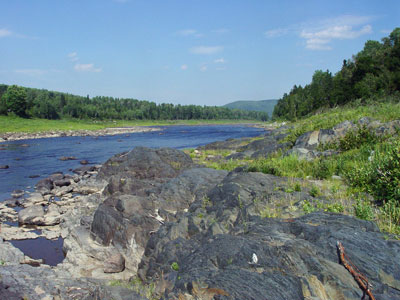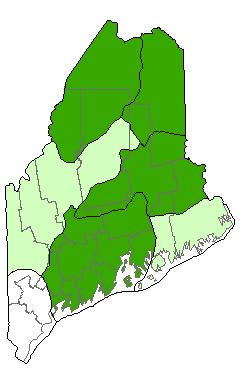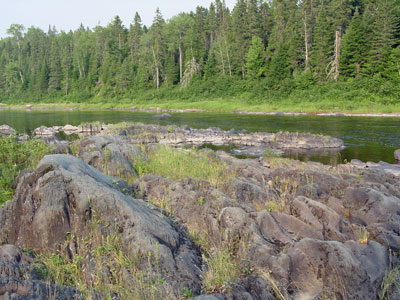DACF Home → Bureaus & Programs → Maine Natural Areas Program → Communities, Plants, and Animals → Natural Community Fact Sheets → Rivershore Outcrop
Printer Friendly Fact Sheet - 550 KB pdf (Get a free copy of Adobe Acrobat Reader)
Rivershore Outcrop
Scientific Name: Bluebell - Balsam Ragwort Shoreline Outcrop; State Rank: S2

- Community Description
- Soil and Site Characteristics
- Diagnostics
- Similar Types
- Conservation, Wildlife and Management Considerations
- Distribution
- Characteristic Plants
- Associated Rare Plants
- Associated Rare Animals
- Examples on Conservation Lands You Can Visit
Community Description: Sparse rivershore vegetation is dominated by herbs with occasional low shrubs. Total cover rarely exceeds 25%. Typical herbs include three-toothed cinquefoil, common hairgrass, hairy goldenrod, silverrod, bluebell, balsam ragwort, and narrow false oats. Shrubs include dwarf bilberry, lowbush blueberry, shrubby cinquefoil, and shadbush; poison ivy may be locally abundant. Where soil allows the growth of taller shrubs (e.g., at the upland transition into adjacent shrub vegetation), red osier dogwood, round-leaved dogwood, and willows may occur. The rare species associated with most of these ledges show an affinity to northern areas; in central Maine, one may find more temperate indicator species, such as Indian grass and little bluestem. Back to top.
Soil and Site Characteristics: This type occurs on dry ledges and outcrops along rivershores. Substrate is typically circumneutral or calcareous slate, with plants growing in vertical fissures. Sites are subject to annual flooding and ice scour, which allows at least a small amount of silt to accumulate in the rock crevices. Back to top.

Diagnostics: Herb dominated sparse vegetation occurs on rivershore outcrops. Back to top.
Similar Types: This is the only herb dominated rivershore ledge community type. Riverside Seeps share many species with moist pockets of these outcrops, but occur on gravelly (unconsolidated) substrates. The geographic transition seen from northern Maine rivers to those in central Maine may warrant splitting the central Maine occurrences into a "Bluestem Shoreline Outcrop" type, but more information is needed from both within and outside of Maine. Back to top.
Conservation, Wildlife and Management Considerations: Many sites are visited on foot for recreation. In sites with moderate to heavy foot traffic, some degradation of the vegetation is apparent. A few sites show some degradation by exotic species such as Japanese knotweed. Several sites are in public ownership or private conservation ownership; many are privately owned.
These rivershore shrublands provide habitat for common bird species that inhabit open shrublands such as common yellowthroat, alder flycatcher, Wilson’s warbler, and Lincoln’s sparrow. Back to top.
Distribution: >Along the major rivers from central Maine northward and eastward. Extends east and north into New Brunswick and west into New Hampshire and Vermont. Landscape Pattern: Small Patch. Linear. Back to top.


Characteristic Plants: These plants are frequently found in this community type. Those with an asterisk are often diagnostic of this community.
- Sapling/shrub
- Black spruce*
- Red spruce
- Sapling/shrub
- Meadowsweet
- Red osier dogwood
- Round-leaved dogwood
- Shining willow
- Western poison-ivy
- Dwarf Shrub
- Dwarf bilberry
- Lowbush blueberry
- Velvet-leaf blueberry
- Herb
- Balsam ragwort
- Bluebell
- Common pussytoes
- Dwarf raspberry
- Early goldenrod
- Field pussytoes
- Kalm's lobelia
- Field pussytoes
- Narrow false oats
- Silverrod
- Stiff aster
- Tufted hairgrass
- Wild chive
- Alpine milk-vetch
- Clinton's bulrush
- Cut-leaved anemone
- Indian grass
- Mistassini primrose
- New England violet
- Pale green orchis
- Purple clematis
- Soft-leaf muhly
- St. John oxytrope
There are no documented rare animals associated with this natural community.
Examples on Conservation Lands You Can Visit
| Example | County |
|---|---|
| Allagash Lake, Allagash Wilderness Waterway | Piscataquis Co. |
| Allagash Public Lands | Aroostook Co. |
| Coburn Park | Somerset Co. |
| Rocky Island Preserve | Aroostook Co. |
